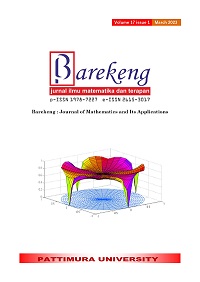IMPLEMENTATION OF THE FUZZY GUSTAFSON-KESSEL METHOD ON GROUPING DISTRICTS/CITIES IN KALIMANTAN ISLAND BASED ON POVERTY ISSUES FACTORS
Abstract
Cluster analysis is an analysis that is useful in summarizing data by grouping objects based on certain similarity characteristics. One of the group analysis is Fuzzy Gustafson-Kessel (FGK) which is the development of the Fuzzy C-Means (FCM) method. The FGK method has a good way in adjusting the form of cluster membership function correctly for a data. This study aims to determine the results of the optimal number of groups based on the Partition Coefficient (PC) and Classification Entropy (CE) validity indexes and to find out the results of grouping 56 districts/cities on the island of Kalimantan based on poverty issue factors in 2021. The optimal number of groups using the FGK method based on the validity indexes of PC and CE are two groups. The first group and the second group each consist of 28 districts/cities in Kalimantan Island.
Downloads
References
Nurjanah, F. Andi dan F. Indriani, “Implementasi Metode Fuzzy C-Means Pada Sistem Clustering Data Varietas Padi,” Kumpulan Jurnal Ilmu Komputer (KLIK), vol. 01, no. 01, pp. 23-22, 2014.
J.-S. R. Jang, C.-T. Sun and E. Mizutani, Neuro-Fuzzy and Soft Computing: A Computational Approach to Learning and Machine Intelligence, New Jersey: Prentice-Hall Inc, 1997.
S. Kusumadewi dan H. Purnomo, Aplikasi Logika Fuzzy: Untuk Pendukung Keputusan Edisi 2, Yogyakarta: Graha Ilmu, 2010.
A. Balasko, J. Abonyi and B. Feil, Fuzzy Clustering and Data Analysis Toolbox: For Use with Matlab, Veszprem: Department of Process Engineering University of Veszprem, 2007.
R. Babuka, P. v. d. Veen and U. Kaymak, "Improved Covariance Estimation for Gustafson-Kessel Clustering," In Proceedings of the 2002 IEEE International Conference on Fuzzy Systems, pp. 1081-1085, 2002.
S. M. H. Jansen, Customer Segmentation and Customer Profiling for a Mobile Telecommunications Company Based on Usage Behavior: A Vodafone Case Study, Maastricht: University of Maastricht (UM), 2007.
A. M. M, H. Sofyan and M. Subianto, "Perbandingan Metode Fuzzy C-Means (FCM) dan Fuzzy Gustafson-Kessel (FGK) Menggunakan Data Citra Satelit Quickbird (Studi Kasus: Desa Lubuk Batee, Aceh Besar)," Jurnal Transenden, vol. 00, pp. 01-05, 2013.
L. Rahmatika, S. Suparti and D. Safitri, "Analisis Kelompok dengan Algoritma Fuzzy C-Means dan Gustafson Kessel Clustering Pada Indeks LQ45," Jurnal Gaussian, vol. 4, no. 3, pp. 543-551, 2015.
I. Izzati, Penerapan Algoritma Fuzzy Clustering Pada Pengelompokan Kabupaten/Kota di Provinsi Jawa Barat Berdasarkan Indikator Kesejahteraan Rakyat., Jatinangor: Unpad Repository, 2020.
I. Minitansia, Pengelompokan Kemiskinan Kabupaten/Kota di Papua dengan Menggunakan Metode K-Means, Surabaya: UIN Sunan Ampel Surabaya, 2021.
K. PPN/Bappenas, Analisis Wilayah dengan Kemiskinan Tinggi, Jakarta: Kedeputian Bidang Kependudukan dan Ketenagakerjaan Kementrian PPN/Bappenas, 2018.
B. P. S. BPS, Jumlah Penduduk Miskin Menurut Provinsi, 2007-2021, Jakarta: Badan Pusat Statsitik Republik Indonesia, 2021.
D. E. Gustafson and W. C. Kessel, "Fuzzy Clustering with a Fuzzy Covariance Matrix," IEEE, vol. 17, pp. 761-766, 1979.
H. Sakai, M. K. Chakraborty, D. Slezak, A. E. Hassanien dan W. Zhu, Transactions on Rough Sets XIV, London: Springer, 2011.
A. Arie, T. Mumtaz and N. Dwima, Data dan Informasi Kemiskinan Kabupaten/Kota Tahun 2021, Jakarta: Badan Pusat Statistik, 2021.
Copyright (c) 2023 Yunda Sasha Paradilla, Memi Nor Hayati, Sifriyani Sifriyani

This work is licensed under a Creative Commons Attribution-ShareAlike 4.0 International License.
Authors who publish with this Journal agree to the following terms:
- Author retain copyright and grant the journal right of first publication with the work simultaneously licensed under a creative commons attribution license that allow others to share the work within an acknowledgement of the work’s authorship and initial publication of this journal.
- Authors are able to enter into separate, additional contractual arrangement for the non-exclusive distribution of the journal’s published version of the work (e.g. acknowledgement of its initial publication in this journal).
- Authors are permitted and encouraged to post their work online (e.g. in institutional repositories or on their websites) prior to and during the submission process, as it can lead to productive exchanges, as well as earlier and greater citation of published works.






1.gif)



